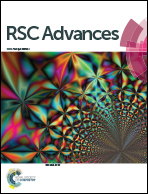Influence of the non-conjugated 5-position substituent of 1,3,5-triaryl-2-pyrazoline-based photosensitizers on the photophysical properties and performance of a dye-sensitized solar cell†
Abstract
We report the effect of the non-conjugated 5-position substituent of pyrazoline-based photosensitizers on the photophysical characteristics and performance of dye-sensitized solar cells (DSSCs). Four photosensitizers which contained different para-substituted phenyl groups (dimethylamine (6a), hexyloxy (6b), ethyl ester (6c), and no substituent (6d)) at the 5-position were synthesized. Although these substituents were not part of the conjugated π-system of the pyrazoline, their absorption maxima showed a red shift from 496 to 510 nm with increasing electron-donating ability. The same trend was observed for their electrochemical characteristics: the oxidation potentials decreased from 1.14 to 0.97 V. In terms of DSSC performance, 6a, which had a strongly electron donating substituent at the 5-position, delivered the highest short-circuit current (Jsc) of 12.3 mA cm−2, an incident photon-to-current conversion efficiency (IPCE) as high as 75%, and the best power conversion efficiency (PCE, η) of 5.7% under AM 1.5 G conditions. Further investigation with the stepped light-induced photocurrent and voltage transients (SLIM-PCV) method revealed that the steric differences between the groups at the 5-position clearly influenced the recombination reaction, resulting in the highest Voc of 636 mV in the DSSC employing 6a with the bulky dimethylamine substituent.


 Please wait while we load your content...
Please wait while we load your content...